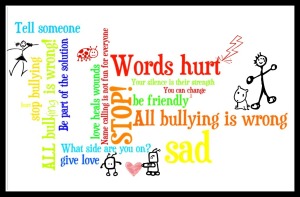Bullying
September 18, 2012SADD and Red Ribbon Week 2012
October 16, 2012Statistics show that 1 in 6 students are regularly bullied in school, but that 1 in 3 students have been bullied. Bullying is tragically commonplace across the country. A survey conducted in 2010 by Clemson University found that while the number of kids being bullied decreased as kids got older, the ones who were bullied in high school were the ones who had been tormented for years, even as far back as elementary school. Bullying is a health problem…for everyone. The victim, the bully, the witnesses and the overall school community are negatively affected by bullying behavior.
Have you ever wondered what to do about bullying? Take action!
 How? Be an Upstander! Witnesses taking action against bullying can decrease the health stress effects.
How? Be an Upstander! Witnesses taking action against bullying can decrease the health stress effects.
A survey of over 13,000 students (grade 5-12) asked what could a witness do that would be help some-one being bullied (Youth Voice Research Project 2010, S.Davis & C.Nixon). Here is a list of what they thought the Most Helpful and the Least Helpful:
| Most Helpful:-spent time with me at school-talked to me at school to encourage me
-gave advice about what I should do -called me at home to encourage me -helped me tell an adult -made a distraction -told an adult |
Least Helpful:-made fun of me-blamed me
-ignored the situation |
At Ypsilanti Middle School, the Youth Advisory Council (YAC) created the slogan “Get Down with Being an Upstander” to show the difference between being a silent witness and someone who takes positive action.
Here are 10 ways for you to be an Upstander from BullyBust.
1) Help others who are being bullied.
2) Stop untrue or harmful messages from spreading.
3) Get friends involved – Sign the pledge!
4) Make friends outside of your circle.
5) Be aware of the bullying policy at your school and in your state. (If there isn’t a policy in place, talk to teachers and office staff about how to go about getting one.)
6) If someone is new at your school, make an effort to introduce them around.
7) Refuse to be a “bystander”.
8) Respect others’ difference and help others to respect differences.
9) Ask a teacher or principal to develop a program or project to reduce and eliminate bullying.
10) Learn more about bullying and help others to learn more about bullying.
Students themselves need to create the social norms where bullying is not cool. Creating  an environment where student-witnesses to bullying can feel safe standing up to a bully is not an easy task, but with a little help from your friends and teachers, it is possible.
an environment where student-witnesses to bullying can feel safe standing up to a bully is not an easy task, but with a little help from your friends and teachers, it is possible.
Find out what your RAHS Youth Advisory Council is doing to stop bullying and create a culture of Upstanders!
Read more at the Youth Voice Project and the Upstander Alliance.
Here is a link to the Michigan Law approved 12/2011 #4163 that addresses bullying in Michigan schools.

